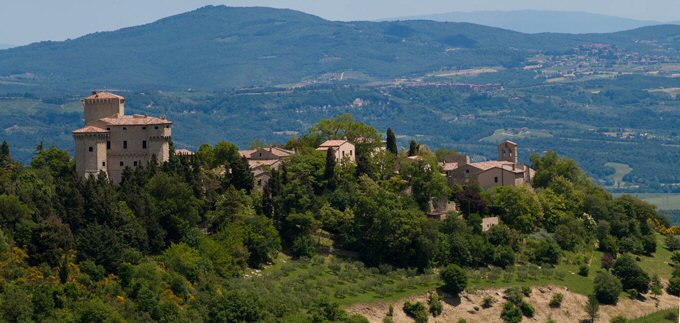Fighine

Latitudine 42.88697 Longitudine 11.91545 Alt. m. 650 ca.
Historical outline
Situated in an excellent strategic position in a watershed between the valleys of the Paglia and Chiana, the village was first mentioned in relation to the Pieve of Santa Maria "de Fighine" in a judicial decree of 1058, while the castle was actually mentioned in an edict of 1266 by which the emperor Federico of Suebia (Schwaben) officially handed it over to the Viscount of Campiglia.
Its position made Fighine the object of dispute between commanders of mercenary troops and local noblemen until the Pope gave it to the Manenti family, who were Counts of the Guelf faction.
In 1446, after gaining control of the castle, the Republic of Siena undertook large-scale works of enlargement and reinforcement of the fortified structures but the work was interrupted in 1451 because of its occupation by papal troops. Pope Pius II restored Fighine to the Sienese only 12 years later. Eventually, with the annexation of Siena to the Grand Duchy of Tuscany, it became the property of the Grand Duke Cosimo dei Medici.
The castle has always been an important feature for the area, suffice it to say that, in the books present in the historical archive of the Comune, the locality is quoted as comparable with Orvieto.
The present structure of the upper part maintains the quadrangular form with three corner towers: the square one, also called the "Old Tower" is much higher than the others, the octagonal one is in the northwest corner and the smaller semi-octagonal one alongside the main gateway of access to the hamlet. The one and a half metre thick defensive walls, starting from the square and semioctagonal towers, are interrupted by small round turrets and, although ruined, still surround the hamlet.
In the section where the gateway into the hamlet is situated, the walls are still of the original height and retain traces of small stone buttresses which support the external walkway around the battlements. The main body of the fortification (towers and exclusive residence) has steep walls crowned with small buttresses.
Visiting the hamlet.

After parking your car in the vicinity of the little church of Santa Maria delle Grazie (outside the walls) you go up on foot to the main gateway, with the awesome bulk of the castle rising up almost threateningly as it protects the hamlet. Inside the circle of walls you can follow the narrow streets and stairways which retreat into the distance and then reunite opposite the Church of St. Michael Archangel. Almost completely uninhabited, the hamlet has been restored during the last 10 years. The only public place is a small restaurant which is open in Spring and Summer.
The Church of St. Michael Archangel was built using one of the towers of the fortified walls as an apse, facing East in accordance with ancient tradition. It has a single nave, the trussed roof and the floor is in terracotta. Inside are paintings of saints of the schools of Orvieto and Florence. Behind the altar stands out a painting of St. Michael Archangel, a work of the artist Bonichi di Lucignano (1750). The fresco on the right wall portrays one of the former owners of the castle, kneeling, in the act of donating the other small church just outside the walls of Fighine, the Church of Santa Maria delle Grazie.